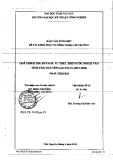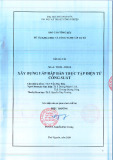
RESEARC H ARTIC LE Open Access
Bone healing after median sternotomy: A
comparison of two hemostatic devices
Rikke F Vestergaard
1,2
, Henrik Jensen
1,2
, Stefan Vind-Kezunovic
1,2
, Thomas Jakobsen
3
, Kjeld Søballe
3
,
John M Hasenkam
1,2*
Abstract
Background: Bone wax is traditionally used as part of surgical procedures to prevent bleeding from exposed
spongy bone. It is an effective hemostatic device which creates a physical barrier. Unfortunately it interferes with
subsequent bone healing and increases the risk of infection in experimental studies. Recently, a water-soluble,
synthetic, hemostatic compound (Ostene®) was introduced to serve the same purpose as bone wax without
hampering bone healing. This study aims to compare sternal healing after application of either bone wax or
Ostene®.
Methods: Twenty-four pigs were randomized into one of three treatment groups: Ostene®, bone wax or no
hemostatic treatment (control). Each animal was subjected to midline sternotomy. Either Ostene® or bone wax was
applied to the spongy bone surfaces until local hemostasis was ensured. The control group received no hemostatic
treatment. The wound was left open for 60 min before closing to simulate conditions alike those of cardiac
surgery. All sterni were harvested 6 weeks after intervention.
Bone density and the area of the bone defect were determined with peripheral quantitative CT-scanning; bone
healing was displayed with plain X-ray and chronic inflammation was histologically assessed.
Results: Both CT-scanning and plain X-ray disclosed that bone healing was significantly impaired in the bone wax
group (p < 0.01) compared with the other two groups, and the former group had significantly more chronic
inflammation (p < 0.01) than the two latter.
Conclusion: Bone wax inhibits bone healing and induces chronic inflammation in a porcine model. Ostene®
treated animals displayed bone healing characteristics and inflammatory reactions similar to those of the control
group without application of a hemostatic agent.
Background
Cardiac surgery is predominantly performed through a
median sternotomy. Today more than 700,000 sterno-
tomies are performed each year in the USA alone [1].
This procedure provides excellent access to all mediast-
inal structures, is quick and easy to perform, and is well
tolerated by most patients. Although complications are
relatively rare, they are serious when they occur.
Immediate complications are intra- and postoperative
bleeding. These predispose to postoperative lack of bone
healing which can lead to pseudoarthrosis and dehis-
cence or even infection and sternal erosion. To prevent
bleeding, bone wax is traditionally used to physically
block blood from oozing out of the spongy bone during
operations which are performed during full hepariniza-
tion. Bone wax consists of sterilized white-bleached hon-
eybees wax (cera alba) blended with a softening agent,
such as paraffin. The product is very effective for dimin-
ishing the amount of intraoperative bleeding. Bone wax
unfortunately has significant potential long-term side
effects. Thus, experimental studies have shown that
when a bone defect is treated with bone wax, the num-
ber of bacteria needed to initiate an infection is reduced
by a factor of 10,000 [2-4]. Furthermore, bone wax acts
as a physical barrier which inhibits osteoblasts from
reaching the bone defect and thus impair bone healing
[5,6]. Once applied to the bone surface, bone wax is
usually not resorbed [7].
* Correspondence: Hasenkam@ki.au.dk
1
Dept. of Cardio-Thoracic and Vascular Surgery, Aarhus University Hospital,
Skejby, Brendstrupgårdsvej 100, 8200 Aarhus N, Denmark
Full list of author information is available at the end of the article
Vestergaard et al.Journal of Cardiothoracic Surgery 2010, 5:117
http://www.cardiothoracicsurgery.org/content/5/1/117
© 2010 Vestergaard et al; licensee BioMed Central Ltd. This is an Open Access article distributed under the terms of the Creative
Commons Attribution License (http://creativecommons.org/licenses/by/2.0), which permits unrestricted use, distribution, and
reproduction in any medium, provided the original work is properly cited.






























